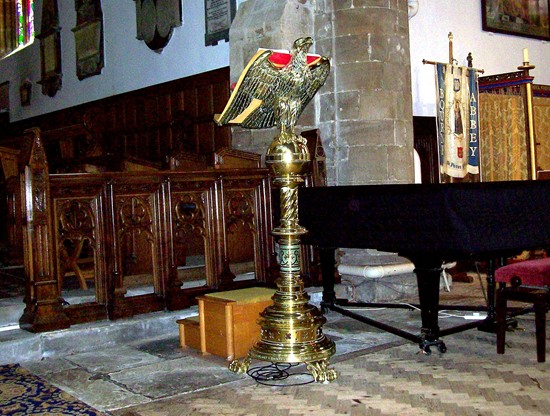|
The lectern
One of the most impressive of our church treasures in Bourne is the magnificent brass lectern which dominates that space between chancel and nave and is therefore always on show during services in which it plays an integral part. A lectern is simply a reading desk, the word adapted from the Latin lectus meaning to read, and usually consists of a sloping top fixed to a stand or pillar on which documents or books are placed as support for reading aloud while standing, as in a scripture reading, lecture or sermon. They can be found in most churches where by tradition they are used as a stand for the bible from which the lessons are read or chanted during services by a priest, deacon, minister, or lay person, depending upon the liturgical traditions of the community, normally situated immediately in front of the pews, so that the reader or speaker faces the congregation. The lectern in the Abbey Church is a particularly striking example of Victorian ostentation yet none the less impressive, standing over six feet high with a sloping top in the shape of an eagle supported on a pedestal. It was restored in 1938 and today the gleaming brass is always polished to perfection, so radiating a golden glow before the congregation. It has always been believed that this lectern was bequeathed to the church in 1902 in memory of a parishioner, Mrs Margaret Dainty, and this reference has been made in the church guides for the past seventy years but my own recent research has found this to be inaccurate although the story behind it is equally fascinating. Mrs Dainty was the wife of Albert Dainty, a prominent agriculturalist who had farmed at Easton, near Stamford, and later at Obthorpe, near Bourne, but who moved into town when he retired from active farming in 1892, having bought Cavalry House in South Street where he spent his final years. This imposing red brick property dates from the early 18th century and was so called because it was once the home of Thomas Rawnsley (1755-1826), a wool stapler of some means and a Deputy Lieutenant of Lincolnshire, who raised a volunteer cavalry troop at his own expense for national defence among local residents when Britain was at war with revolutionary France when invasion was threatened by Napoleon but by 1816, the danger had receded and the unit was disbanded. Rawnsley died in 1826, aged 71, and there are memorial tablets in the north arcade of the Abbey Church to him, his wife, Deborah, and six of their children who died in infancy, although they were placed high on the wall of the north arcade and can only be seen with difficulty from the nave. The house, which is now Grade II listed, is a short distance from the church and Albert and Margaret Dainty both worshipped there as well as being associated with most of the social functions in the town and, being a generous man, he frequently allowed his attractive gardens to be used for various events such as charity fetes and promenade concerts given by the Bourne Town Band that were so popular during the closing years of the 19th century. But Mr Dainty was dogged by ill health during his final years and in the last two months he was confined to his house apart from short excursions around town in a Bath chair. He also tried to recoup his health with a visit to the south of England and had only returned the week before his death on Monday 19th May 1902, aged 58, which was sudden, although not unexpected. His funeral was held with a full choral service at the Abbey Church on Friday 23rd May 1902 attended by family, friends and members of the parochial church council followed by committal prayers and burial in the town cemetery in South Road where a stone kerb surround marks his grave. At that time, Mr Dainty’s wife anticipated that she would eventually join him because she bought a double plot but it was never used. She lived on for another thirty years and by then she had left Bourne. Margaret Dainty sold up and moved to the south of England, spending her last years living close to relatives in the New Forest at Burley, near Ringwood, Hampshire, where she died on 25th December 1936, aged 77, and is buried in the local churchyard. The lectern in the Abbey Church therefore appears to have been bought by her in remembrance of her husband after he died and we are pleased to put the record straight. The bible which currently lies on it has its own provenance inscribed inside that it was presented by the family and friends of Jack Burchnell (1909-73), devoted worshipper at the Abbey Church where he also served as churchwarden from 1963-64 and again from 1967-68. He was also choirmaster for twenty years although he was forced to retire from this due to illness. One of his other musical successes was in founding the Burchnell Singers, a small but enthusiastic group of vocalists who made many appearances locally at concerts and other functions free of charge for worthwhile causes. The lectern therefore remembers two staunch members of the Abbey Church in a tangible way and it is through such gifts and monetary bequests that the memory of those who served endures while the building continues as a beacon of faith within our community as it has done for almost 900 years. See also Cavalry House An Edwardian garden party
Go to: Main Index Villages Index |
